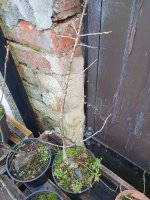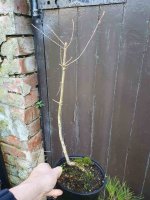Hi all
I wanted to ask some questions about developing these oak saplings but I figured a broader discussion around developing nursery stock would be more beneficial.
This may be an oversimplification but I understand that good bonsai must start with good nebari and a good trunk.
To get a good trunk you must grow a tree in the ground for many years or train in a suitable container environment for an even longer period of time. For a deciduous tree like an oak or maple, the trunk line is set with that first chop and subsequent leaders are trained and cut back to develop taper and movement.
When you have saplings such as these, how should you approach balancing allowing the tree to grow a solid trunk with preventing any structural flaws from developing over time ?
Would you start by letting these run another 5 years then re-evaluate/make any chops/adjustments ?

Would you immediately remove this boring long straight section, and regrow to develop better movement?

My gut is telling me to just let them grow this season, let them develop as much foliage as possible to fuel growth of the trunk - but is this wasted growth if all I am developing is a straight boring stick in a pot ?
(At minimum I expect I will repot them this year into pond baskets and try and tackle the taproot)
Thanks !
I wanted to ask some questions about developing these oak saplings but I figured a broader discussion around developing nursery stock would be more beneficial.
This may be an oversimplification but I understand that good bonsai must start with good nebari and a good trunk.
To get a good trunk you must grow a tree in the ground for many years or train in a suitable container environment for an even longer period of time. For a deciduous tree like an oak or maple, the trunk line is set with that first chop and subsequent leaders are trained and cut back to develop taper and movement.
When you have saplings such as these, how should you approach balancing allowing the tree to grow a solid trunk with preventing any structural flaws from developing over time ?
Would you start by letting these run another 5 years then re-evaluate/make any chops/adjustments ?

Would you immediately remove this boring long straight section, and regrow to develop better movement?

My gut is telling me to just let them grow this season, let them develop as much foliage as possible to fuel growth of the trunk - but is this wasted growth if all I am developing is a straight boring stick in a pot ?
(At minimum I expect I will repot them this year into pond baskets and try and tackle the taproot)
Thanks !


